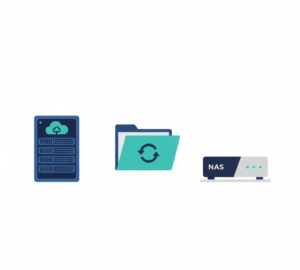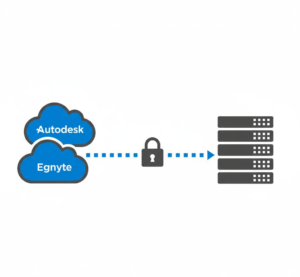Intro
There comes a time in an organization’s life cycle when the transition to a different cloud technology decision is made. With this crucial decision come several questions, such as:
- What are the specific business reasons for adopting a new cloud system?
- What is your current data environment?
- How will the new cloud system enhance your operational efficiency?
- What are the expected improvements in security, costs, and data management?
- How do you plan to manage the migration process?
- What are the anticipated challenges during the transition?
- How will this move align with your overall IT strategy?
In this blog post, we will guide you through the preparation process and help you facilitate the migration of your data into new cloud technology that meets your organization’s needs by asking the right questions in three main aspects. Let’s begin.
Assessment Workflow
A crucial aspect of your initial migration evaluation involves examining the potential impact on your data due to changes in the cloud infrastructure. For managing it, it is recommended to use cloud migration tools that enable discovery and assessment (such as Cloudsfer). With these tools, you can assess your data mapping and get a clear overview of your existing environment. By scanning and analyzing your current infrastructure, applications, and data setups, better plans can be made for the migration, and the best “candidates” can be identified for the new cloud environment.
The more you understand your data, the more you can map its dependencies and evaluate its risks, and the better informed your decisions will be. Through this process, migration risks can be minimized while business continuity can be maintained. Familiarity with top migration tools is essential to ensure that your migration meets the expected business results, staying on schedule, within budget, and at an acceptable risk level. If your organization lacks the specific knowledge required for data migration, it is advisable to consult a partner who can provide expert recommendations on best practices for implementing automated migration and agile frameworks to avoid common migration errors.
A comprehensive strategy for controlling both source and target cloud environments—including the transfer of multi-user capabilities, versions, metadata, access, and security—is essential. Migration tools provide a clear view of both environments and the transfer process itself, allowing you to track failures, maintain full control and authority, and ensure the migration is conducted automatically for zero risk. This enables you to support your core business operations while maintaining top-notch security and compliance.
Successful cloud data migration depends on thorough pre-assessment and meticulous planning.
Here are questions to ask:
- How might new cloud infrastructure affect our current data?
- Are there any critical data that require special attention during migration?
- Are our methods and tools adequate for a comprehensive pre-migration assessment?
- How prepared are we to manage the cloud technology effectively post-migration?
- What strategies do we have in place to maintain control over versions, metadata, access, and security in a multi-user cloud environment?
- Should we consider partnering with experts to fill any gaps in knowledge or abilities?
Operations
Transitioning to cloud technology has the potential to revolutionize your business operations. However, the workloads that you transfer require ongoing management. As part of cloud transfer, you must select monitoring and automation tools that are tailored specifically for cloud file transfer, ensuring they can be run, utilized, maintained, and restored efficiently in alignment with your current cloud system source and your future cloud system target.
Additionally, it’s important to pinpoint necessary changes in processes and determine the training needed for a seamless transition to the cloud. A well-managed operations team lays the foundation for sustaining business operations, covering everything from strategic planning to real-time problem-solving.
Effective cloud transition requires a combination of the right tools and strategic training for a successful and sustainable business transition.
Here are questions to ask:
- Which monitoring and automation tools are best suited for our cloud migration needs?
- How do these tools integrate with our existing cloud systems?
- How will we manage the ongoing operations of transferred workloads in the cloud?
- What training and support will the operational teams need for a successful transition to the cloud?
- What specific skills and knowledge are required for our teams to operate confidently in the cloud?
Security
Security should be your top concern when migrating to the cloud therefore, it’s crucial that the organization’s IT security team actively supports and participates in the pre-migration planning process. This involvement ensures alignment and prevents any disputes or misunderstandings regarding the adoption and implementation of security, regulatory, and compliance measures.
In the cloud context, cloud providers work in a shared responsibility model between your organization and the cloud service provider.
The shared responsibility model ensures that while the cloud provider manages the infrastructure’s security, the customer is responsible for securing their data, applications, and user access. This means the customer retains control over their own security measures within the cloud environment.To guarantee a proper transition, it’s important to assign a dedicated individual to oversee security and involve them from the initial stages of pre-migration planning. For instance, traditional Intrusion Detection and Prevention Systems (IDPS) are ineffective in cloud environments. Therefore, ensure that the IT department, which primarily acts as the defender of security, fully understands the nuances of cloud security and is able to adhere to a well-defined cloud security strategy or framework.
Active IT Security involvement in pre-migration planning ensures successful cloud adoption.
Here are questions to ask:
- What aspects of our current security measures will need to be adapted or enhanced for the cloud environment?
- Are our current security tools like IDPS suitable for the cloud, or do we need to consider new solutions?
- Is it clear to us what the shared responsibility model in cloud security means?
- Who will oversee the security aspects of the cloud migration?
- What criteria are we using to select the individual responsible for overseeing security during the migration?
- What strategies and frameworks are we considering to guide our cloud security practices?
Summing Up
By addressing assessment workflows, operations, and security considerations through thorough preparation and deep evaluation of your migration steps, we are confident that your organization can effectively leverage cloud technology to further its business goals. Cloudsfer can act as your trusted partner in this crucial step, and our expert team would be happy to support and answer any questions or concerns you might have.





